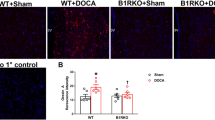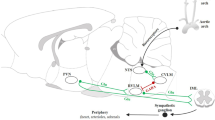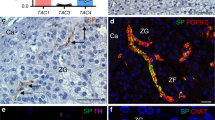Abstract
In the initial experiments reviewed here, we show that atrial natriuretic peptide (ANP) plays an important inhibitory role in the control of sodium chloride and water intake since injections of ANP into the third ventricle (3V) caused a reduction in dehydration-induced drinking and also the drinking of salt in salt-depleted rats. Attention was then turned to the possible role of the brain ANP neurons in producing natriuresis which had earlier been shown to be caused by stimulations within the anterior ventral third ventricular region (AV3V). Stimulation in this region by carbachol produced natriuresis accompanied by a dramatic increase in plasma ANP concentrations and increased content of the peptide in medial basal hypothalamus (MBH), neurohypophysis (NH) and anterior pituitary gland (AP), without alterations in the content of ANP in lungs or atria. This suggested that the natriuresis resulting from the stimulation is brought about, at least in part, by the release of ANP from the brain. Conversely, there was a dramatic decline in plasma ANP at both 24 and 128 h after AV3V lesions had been placed. In view of the much larger quantities of the peptide stored in the atria, it is probable that the changes in the atrial release of the peptide were the main factors altering plasma ANP, but that there was concomitant alteration in the release of brain ANP as well. Blood volume expansion (BVE) by intraatrial injection of isotonic saline in the rat is a profound stimulus for ANP release. Lesions in the AV3V region, median eminence, or neurohypophysectomy blocked BVE-induced release of ANP indicating the crucial participation of the CNS in the response of ANP and natriuresis. Baroreceptor impulses from the carotid-aortic sinus regions and the kidney are important in the neuroendocrine control of ANP release since deafferentation of these regions lowered basal plasma ANP concentrations and prevented the increase after BVE. The evidence indicates that the ANP release, in response to BVE, is mediated by afferent baroreceptor impulses to the AV3V, which mediates the increased ANP release via activation of the hypothalamic ANP neuronal system. Our recent data support the hypothesis that BVE causes the release of ANP from ANPergic neurons in the hypothalamus that in turn stimulates release of oxytocin from the neurohypophysis. This oxytocin acts to release ANP from the right atrium that has negative chrono- and inotropic effects in the right atrium to reduce cardiac output, thereby reducing effective circulating blood volume. Then, the released ANP circulates to the kidneys and evokes natriuresis to return circulating blood volume to normal. This is further accomplished by reduction in intake of water and salt mediated also by brain ANP.
This is a preview of subscription content, access via your institution
Access options
Subscribe to this journal
Receive 12 print issues and online access
$259.00 per year
only $21.58 per issue
Buy this article
- Purchase on Springer Link
- Instant access to full article PDF
Prices may be subject to local taxes which are calculated during checkout
Similar content being viewed by others
Author information
Authors and Affiliations
Rights and permissions
About this article
Cite this article
Antunes-Rodrigues, J., Favaretto, A., Gutkowska, J. et al. The neuroendocrine control of atrial natriuretic peptide release. Mol Psychiatry 2, 359–367 (1997). https://doi.org/10.1038/sj.mp.4000308
Received:
Accepted:
Issue Date:
DOI: https://doi.org/10.1038/sj.mp.4000308



